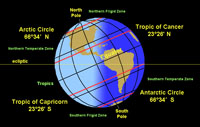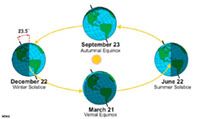1.11: Zones of the Earth Climate System
- Page ID
- 9699
Zones of the Earth Climate System
On any location on the planet, the slow progress of seasonal changes are related to observable migration that the path the Sun follows through the sky over the cycle of one year. Seasons occur because:
a) the Earth spins (rotates) on its axis marked by the north and south poles; and,
b) the axis of the spinning Earth is tilted about 23.5° relative to ecliptic plane. (The ecliptic plain flat circular path the Earth follows as it revolves around the Sun in the orbital plane)(Figures 1-27 and 1-28).
Only twice a year, on the spring and fall equinoxes is the Sun directly above the equator (0°). The summer solstice occurs on June 21 when the Sun is directly overhead at noon along the latitude 23.5° north (a circle on the globe called the Tropic of Cancer). Likewise, the winter solstice occurs on December 20 when the is directly overhead at noon along the latitude 23.5° south (a circle on the globe called the Tropic of Capricorn).
The tropics are the region of the world between the parallels of latitude about north (Tropic of Cancer) and 23°5ʹ south (Tropic of Capricorn) on opposite sides of the equator (0°).

Figure 1.27. Location of tropics, temperate, and polar zones.
The term polar is used to describe the high latitude cold regions surrounding the Earth's north and south poles. The Arctic Circle runs 66.33° north of the equator. North of this line is the North Frigid Zone (also known as The Land of the Midnight Sun where the Sun never sets on the summer solstice). The Antarctic Circle is parallel of latitude approximately 66.33° south and defines the northern boundary of the South Frigid Zone. The Antarctic Circle marks the approximate limit south of which the Sun remains above the horizon all day on the summer solstice.
The regions between the tropics and the polar regions are called temperate zones (North Temperate Zone and South Temperate Zone).

Figure 1.28. Seasons are caused by the tilt in Earth's axis as it orbits around the sum.


